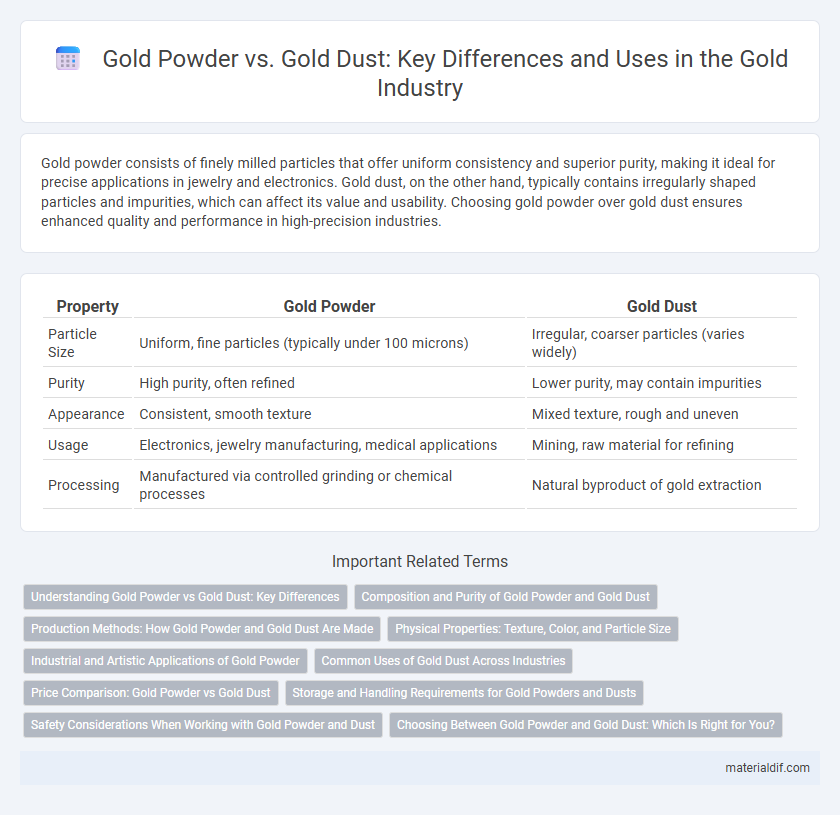Gold powder consists of finely milled particles that offer uniform consistency and superior purity, making it ideal for precise applications in jewelry and electronics. Gold dust, on the other hand, typically contains irregularly shaped particles and impurities, which can affect its value and usability. Choosing gold powder over gold dust ensures enhanced quality and performance in high-precision industries.
Table of Comparison
| Property | Gold Powder | Gold Dust |
|---|---|---|
| Particle Size | Uniform, fine particles (typically under 100 microns) | Irregular, coarser particles (varies widely) |
| Purity | High purity, often refined | Lower purity, may contain impurities |
| Appearance | Consistent, smooth texture | Mixed texture, rough and uneven |
| Usage | Electronics, jewelry manufacturing, medical applications | Mining, raw material for refining |
| Processing | Manufactured via controlled grinding or chemical processes | Natural byproduct of gold extraction |
Understanding Gold Powder vs Gold Dust: Key Differences
Gold powder consists of fine, uniform particles produced through controlled processes such as milling or chemical precipitation, resulting in consistent purity and particle size ideal for applications in electronics and cosmetics. Gold dust, typically found in nature, comprises irregular, coarse particles mixed with impurities, making it less refined and primarily valuable for raw extraction and smelting. Understanding these distinctions helps industries optimize their use of gold materials based on precision, purity, and application requirements.
Composition and Purity of Gold Powder and Gold Dust
Gold powder typically consists of finely ground pure gold particles with a high degree of uniformity and consistent purity levels, often exceeding 99.5%. In contrast, gold dust usually contains a mixture of gold flakes and impurities such as other metals, minerals, and dirt, resulting in lower overall purity. The composition of gold powder makes it ideal for industrial and scientific applications requiring precise metallic content, whereas gold dust is commonly found in natural alluvial deposits with variable purity.
Production Methods: How Gold Powder and Gold Dust Are Made
Gold powder is typically produced through mechanical milling, chemical precipitation, or atomization processes that create fine, uniform particles suitable for industrial applications. Gold dust, on the other hand, generally results from natural erosion and weathering of gold-bearing rocks or as a byproduct of mining and crushing operations, consisting of irregular, coarser fragments. The production methods thus differ significantly, with gold powder involving controlled refinement techniques and gold dust arising more organically or from rough processing.
Physical Properties: Texture, Color, and Particle Size
Gold powder features a fine, homogeneous texture with particles typically under 100 microns, exhibiting a bright, metallic yellow hue. Gold dust consists of irregular, coarser fragments ranging from 100 microns to several millimeters, often appearing duller due to varied surface reflections. The particle size and texture differences significantly impact their applications in electronics, jewelry, and pyrotechnics.
Industrial and Artistic Applications of Gold Powder
Gold powder exhibits a finer granularity and higher purity compared to gold dust, making it ideal for precision industrial applications such as electronics manufacturing and specialized coatings. In artistic contexts, gold powder is favored for its smooth texture and ability to create intricate details in gilding, sculptures, and decorative finishes. The consistent particle size of gold powder ensures uniform application and enhanced visual effects in both industrial and artistic pursuits.
Common Uses of Gold Dust Across Industries
Gold dust finds extensive use in electronics manufacturing, where its excellent conductivity facilitates efficient circuit connections. It is also employed in the cosmetics industry to add luxury and shimmer to products like face masks and makeup. In metal refining and jewelry making, gold dust serves as a raw material for alloy creation and intricate decorative applications.
Price Comparison: Gold Powder vs Gold Dust
Gold powder typically commands a higher price than gold dust due to its finer particle size and higher purity, which enhance its value in industrial and decorative applications. Gold dust, being coarser and often mixed with impurities, generally sells at a discount compared to gold powder, making it less valuable per gram. Market demand for refined forms like gold powder influences pricing disparities, reflecting its premium status in processes requiring precise gold content.
Storage and Handling Requirements for Gold Powders and Dusts
Gold powders and gold dust require careful storage in airtight, moisture-free containers to prevent contamination and oxidation. Both forms should be handled in well-ventilated areas with antistatic measures to avoid dispersion and inhalation risks. Proper labeling and secure containment minimize environmental exposure and ensure safe transport and usage.
Safety Considerations When Working with Gold Powder and Dust
Gold powder and gold dust both pose inhalation risks, requiring proper respiratory protection such as N95 masks or respirators to prevent lung irritation and potential long-term health effects. Handling these fine particulates demands working in well-ventilated areas or using local exhaust ventilation to minimize airborne exposure. Avoiding open flames and static electricity is crucial, as gold dust can be flammable when dispersed in the air, making strict safety protocols essential in industrial and laboratory settings.
Choosing Between Gold Powder and Gold Dust: Which Is Right for You?
Gold powder offers a finer, more consistent particle size ideal for intricate applications such as electronics and jewelry making, while gold dust consists of coarser particles suitable for melting and refining processes. The choice between gold powder and gold dust depends on the intended use, precision requirements, and desired purity levels. Assessing factors like particle uniformity, handling ease, and application specificity ensures the optimal form of gold for your project or investment.
Gold powder vs Gold dust Infographic

 materialdif.com
materialdif.com